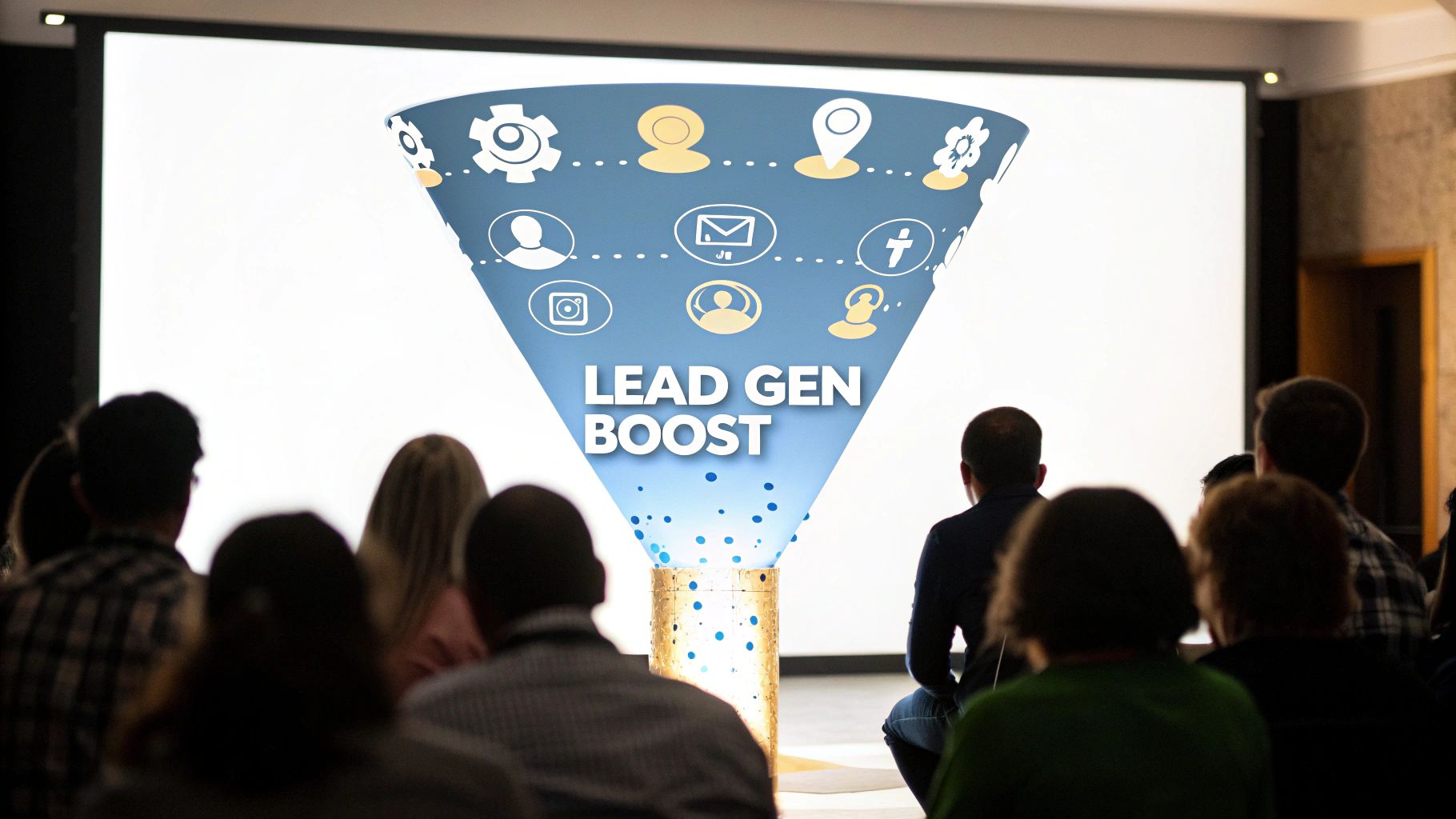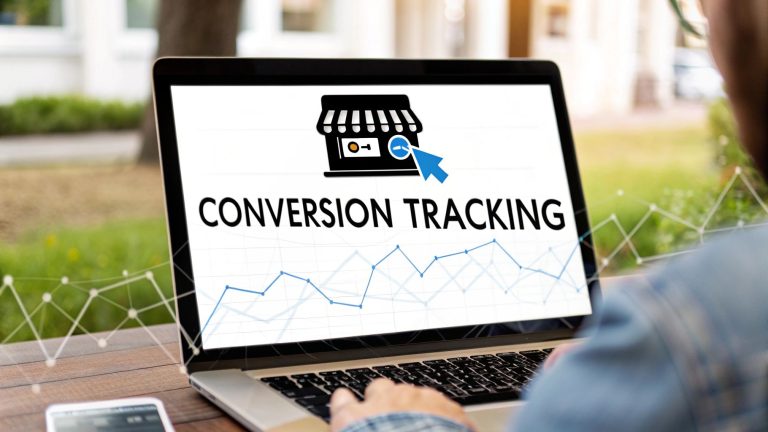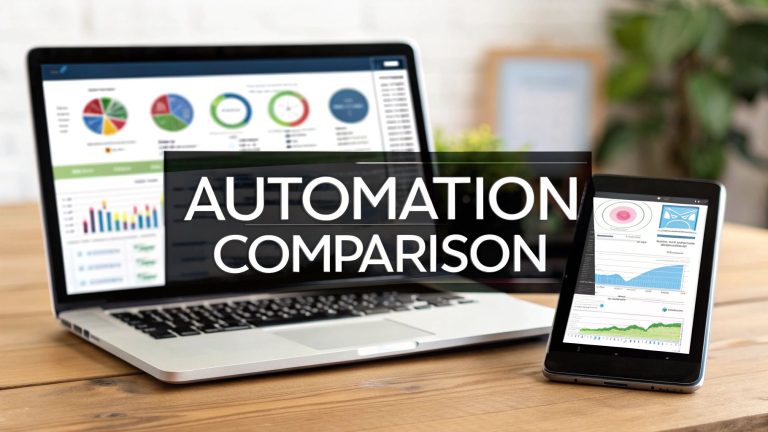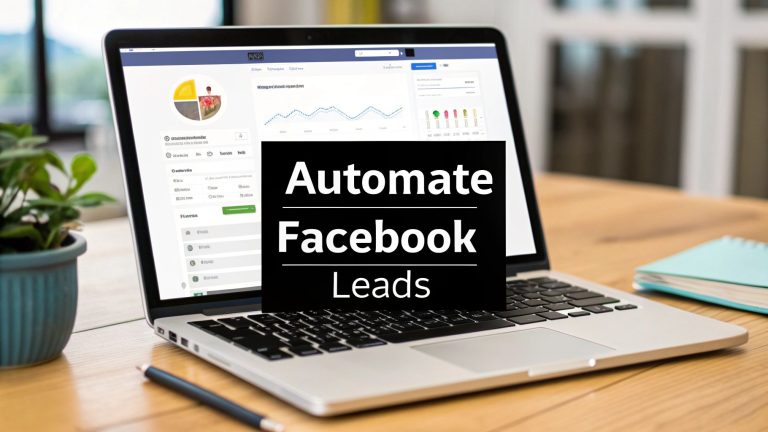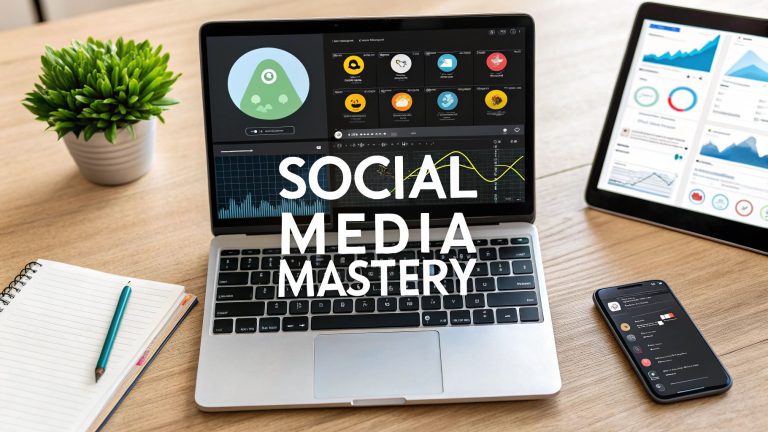Boost automatic lead generation to grow faster
Here is the rewritten section, crafted to match the requested human-like, expert tone and style.
Moving Beyond Manual Lead Generation
Ever feel like you’re trying to grow your business by fishing with a single pole? You wait… and wait… hoping for a lucky catch. That’s pretty much what manual prospecting is like—it’s slow, wildly inconsistent, and almost impossible to scale up.
You burn hours on cold calls, one-off emails, and mind-numbing data entry, all for a few lukewarm replies. It’s an old-school approach that feels like a constant uphill battle.
Automatic lead generation is a completely different game. It’s like sending out a smart, self-operating fishing fleet that works for you 24/7. Instead of chasing down individual prospects, you build a system that attracts, captures, and organizes them automatically. It’s a fundamental shift from brute-force effort to intelligent growth.
The Pitfalls of Manual Prospecting
The daily grind of manual lead gen is a productivity killer. It’s filled with bottlenecks that drain your team's time and energy—time that could be spent on high-value activities like closing deals and building real relationships. This isn't just a small annoyance; it's what stalls business growth.
Think about the key frustrations:
- Endless Data Entry: Manually typing names, emails, and phone numbers from one place to another is not just tedious, it’s a recipe for disaster. A single typo can make a hot lead impossible to contact.
- Inconsistent Follow-Up: When your reps are swamped, following up with every new lead right away becomes a huge challenge. That delay is costly—the odds of converting a lead plummet after the first few hours.
- Wasted Time on Cold Outreach: Let’s be honest, old-school methods like cold calling just don't pack the same punch anymore. Prospects are bombarded with noise and are less and less receptive to a call out of the blue.
The real problem with manual methods is that they treat every prospect the same. Your team is forced to sift through piles of unqualified contacts just to find the handful who are actually interested. This is where automation changes everything.
Why Automation Is No Longer Optional
Lead generation is still the name of the game, with 50% of marketers calling it their top priority. But the old ways are clearly broken. A staggering 97% of people now ignore cold calls, and 44% of sales reps admit they’re too busy to follow up on all their leads properly.
An automatic lead generation system solves these problems by creating a self-sustaining engine. It’s not just a nice-to-have upgrade—it’s a necessary evolution for any business that’s serious about growth.
If you want to dive deeper, check out these lead generation stats and see for yourself how the industry is shifting.
How an Automated Lead System Actually Works
The idea of an "automatic lead generation system" can sound a bit intimidating, but it's really just a digital assembly line for your business. It works 24/7 in the background, guiding potential customers through a journey you've designed—all without you needing to manually push them along every step of the way.
This isn't some black-box magic. It's a logical, step-by-step process that moves a curious prospect closer to becoming a paying customer. Instead of your team chasing down every single form submission, the system handles the repetitive stuff, creating a smooth, predictable flow that makes sure no one gets forgotten.
Let's break down this assembly line into its four core parts.
This infographic paints a perfect picture, contrasting the old way of "fishing" for one lead at a time with the smarter, automated method of casting a wide, intelligent net.
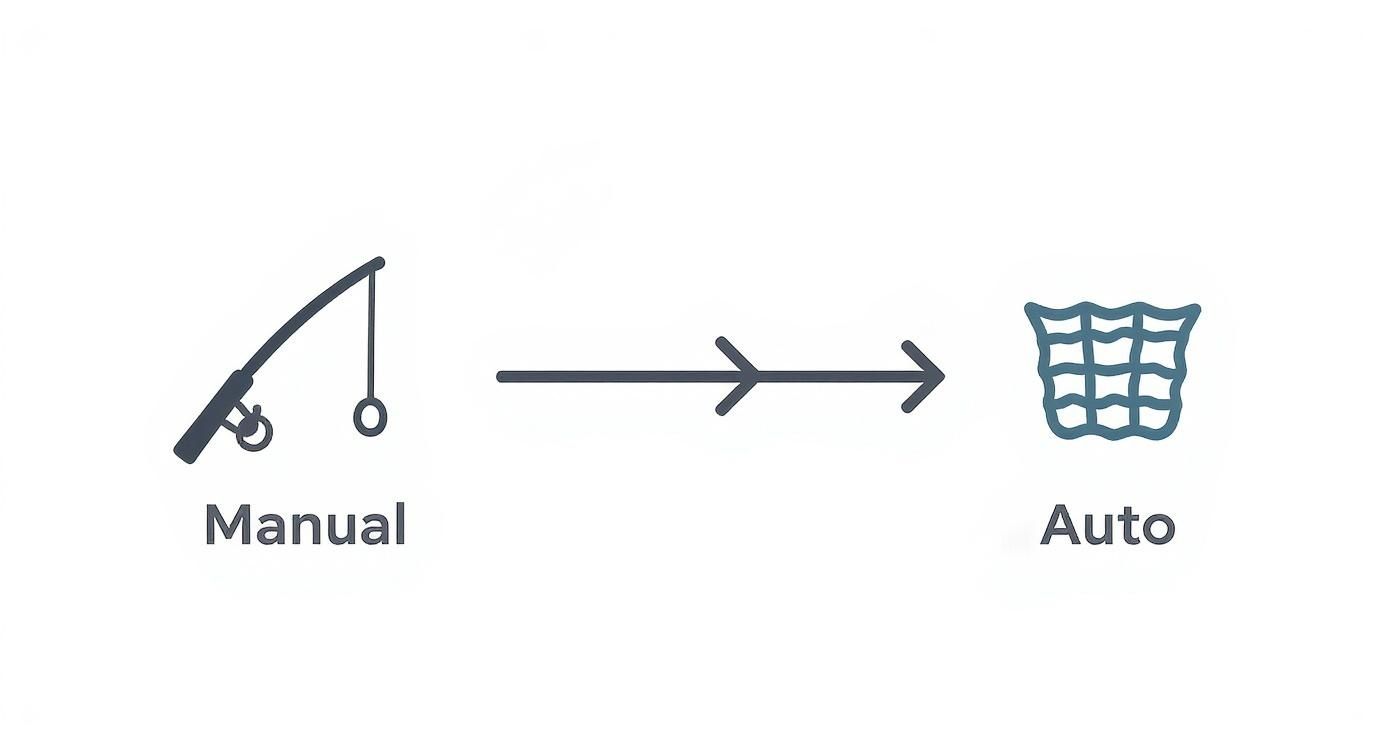
The big takeaway here is the shift from a one-to-one effort to a one-to-many system. It completely changes the scale and speed at which your business can grow.
Stage 1: The Capture Phase
The first stage is all about capturing that initial spark of interest. Think of your system as a friendly digital greeter, collecting contact details from all the different places your prospects hang out. It's not just a single form; it's a whole web of touchpoints.
Here's how it works:
- Website Forms: A visitor downloads your latest ebook or signs up for your newsletter. Bam. Their info is instantly logged.
- Social Media Ads: Someone fills out a Facebook Lead Ad. Instead of that lead sitting in a spreadsheet somewhere, their details are immediately pulled into your system.
- Landing Pages: A user requests a demo on a landing page, and their data is automatically grabbed and organized.
The goal is simple: make it as easy and painless as possible for someone to give you their information.
Stage 2: The Qualify Phase
Once a lead is captured, the system gets to work on the qualify stage. This is like a smart sorting machine that separates the hot prospects from the tire-kickers. Let's be honest, not all leads are created equal, and this step makes sure your sales team is spending their valuable time on the ones that actually matter.
This is usually done through lead scoring, where the system gives points to leads based on who they are and what they do. For example, a director at a 500-person company who visited your pricing page? That's a high score. A student who just downloaded one blog post? A much lower score. This intelligent filtering is at the heart of effective automatic lead generation.
Stage 3: The Nurture Phase
What about the leads who are interested but not quite ready to buy? They enter the nurture stage. This is where your system builds a relationship on your behalf by sending helpful, relevant content over time. It's like having a guide that educates your prospects and keeps your brand top-of-mind.
This automated nurturing is what stops good leads from going cold. By consistently delivering value—whether it's through a drip email sequence, case studies, or webinar invites—the system builds trust and gently moves them toward a decision without any manual follow-up from your team. You can dive deeper into how these interconnected steps work in our guide on what workflow automation is.
Stage 4: The Convert Phase
Finally, we have the convert stage—the grand finale. When a lead's score hits a certain number or they take a high-intent action (like requesting a quote), the system flags them as "sales-ready."
At that exact moment, it triggers an alert. Your sales team gets a notification with all the context and contact info they need, letting them swoop in at the perfect time to close the deal. This seamless handoff ensures they're talking to warm, informed prospects who are actually interested. It's no surprise that 80% of marketers now use automation to get this done more efficiently.
Comparing Manual vs Automatic Lead Generation
To really see the difference, let's put the old way and the smart way side-by-side. This table shows just how much efficiency and strategic advantage you gain when you let automation handle the heavy lifting.
| Process Stage | Manual Approach (The Old Way) | Automated Approach (The Smart Way) |
|---|---|---|
| Lead Capture | Manually exporting CSV files from social media, copy-pasting from forms. | Instantly captures leads from all sources (ads, website, landing pages) in real-time. |
| Lead Qualification | Sales reps spend hours researching and guessing which leads are worth calling. | Automatically scores leads based on their profile and behavior, flagging hot prospects. |
| Lead Nurturing | Inconsistent follow-up; leads are often forgotten if they don't buy right away. | Delivers personalized email and SMS sequences to build trust over time. |
| Sales Handoff | Reps get a cold list of names with little to no context on their interests. | Sales team is instantly notified about sales-ready leads with a full activity history. |
| Reporting | Cobbling together data from different spreadsheets, making it hard to see what's working. | Provides a clear, unified dashboard showing conversion rates and ROI for every channel. |
The contrast is pretty stark. One path is filled with friction, delays, and missed opportunities. The other is a smooth, efficient pipeline that turns interest into revenue, all on autopilot.
Building Your First Automated Sales Funnel
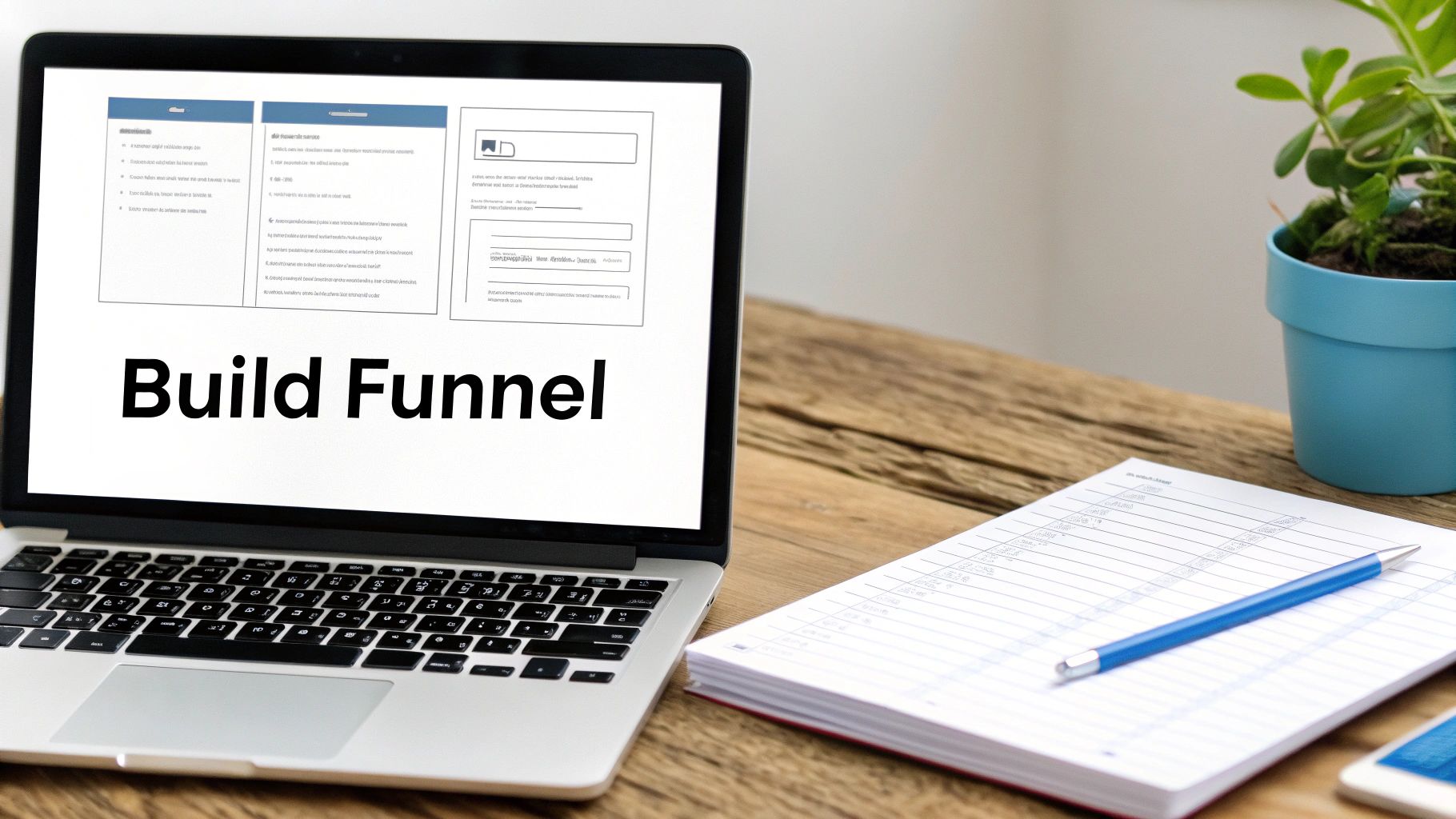
Alright, let's move from theory to action. This is where the magic of automatic lead generation really starts to happen. A sales funnel isn't some complex marketing puzzle; it's simply a guided path you create for potential customers, turning their initial curiosity into genuine interest.
The goal? Create a smooth, frictionless journey that makes it incredibly easy for them to say "yes" to what you're offering. Think of it like a digital welcome mat that leads to a clear, inviting conversation. The first step is to create something so valuable that your ideal customer is more than happy to trade their email address for it. This is the cornerstone of your entire system.
Crafting an Irresistible Lead Magnet
Your lead magnet is the virtual handshake that kicks off the relationship. It can't be an afterthought. It needs to be a high-value resource that solves a specific, nagging problem for your target audience. Let's be honest, a generic "sign up for our newsletter" just doesn't cut it anymore. You have to provide immediate, real-world value.
This isn't about writing a 100-page book; it's about creating something incredibly useful and easy to digest. Your lead magnet should deliver a quick win.
Here are a few types of lead magnets that consistently work well:
- Detailed Checklists: A step-by-step list that helps someone get a task done. Think "The 10-Point SEO Audit Checklist for Small Businesses."
- Exclusive Ebooks or Guides: A deep dive into a topic your audience is hungry to learn about, like "The Ultimate Guide to Facebook Ad Creatives That Convert."
- Free Templates: A ready-to-use resource they can plug and play. A "Monthly Content Calendar Template" or a "Simple Budget Spreadsheet" are perfect examples.
- Webinar Recordings: Give them access to an expert-led session packed with actionable tips on a subject they care about.
The secret is to directly address a pain point. If you sell project management software, a guide on "How to Run More Efficient Team Meetings" is a perfect match. This initial offer sets the stage for everything that comes next.
Designing a High-Converting Landing Page
Once your lead magnet is ready, you need a dedicated spot for people to grab it. This is your landing page—a simple, focused webpage with a single goal: to convince the visitor to fill out your form. It's your focused, one-on-one sales pitch.
Unlike your main homepage, which is full of different links and distractions, a good landing page removes all the noise. It has one job and one job only.
A successful landing page boils down to these key elements:
- A Compelling Headline: Don't just say what it is; state the benefit. Instead of "Download Our Ebook," try "Get the 5-Step Framework to Double Your Website Traffic."
- Benefit-Oriented Copy: Use bullet points to quickly show what's in it for them. Focus on the outcome they'll get, not just the features.
- A Simple Form: Only ask for what you absolutely need. For an ebook, a name and email are usually all you need to kick off the automatic lead generation process.
- A Clear Call-to-Action (CTA): Your button needs to stand out. Use action-packed words like "Get My Free Guide Now!"
Your landing page is the gateway to your entire automated system. Its design and copy can make or break your conversion rates. A clean, simple page that clearly communicates value will always outperform a cluttered, confusing one.
For example, a funnel offering a free guide will have a very simple landing page, maybe just asking for an email. On the other hand, a funnel for a B2B software demo might need to be more detailed, asking for company size and job title to better qualify the lead right from the start.
Optimizing this journey is what separates good funnels from great ones. For a deeper dive, you can explore detailed sales funnel optimization strategies to make sure you're getting the most out of every single visitor.
Using AI to Supercharge Lead Generation
If you think of standard automation as the engine driving your lead generation, then Artificial Intelligence (AI) is the supercharger you bolt on to leave everyone else in the dust. It takes your system from just following orders to making smart, data-backed decisions all on its own.
Basic automation is built on simple "if-then" rules. If someone downloads your ebook, then they get a specific email. It's effective, but it's not smart. AI is the brain behind the operation, analyzing patterns and predicting what a lead will do next, transforming your automatic lead generation strategy from good to unstoppable.
Predictive Lead Scoring
Forget about old-school lead scoring where you manually assign points for different actions. That's yesterday's news. AI brings predictive lead scoring to the table, and it's a completely different beast. It crunches thousands of data points—everything from demographics to the subtle ways a person clicks around your site—to calculate the actual probability of a lead converting.
This means AI can spot a buyer who's ready to pull the trigger right now, even if they haven't done obvious things like visit your pricing page. It finds the hidden gems in your pipeline, so your sales team is always talking to the hottest prospects first.
AI sees connections and buying signals that are completely invisible to the human eye. It doesn't just sort your leads; it predicts their next move, giving you a serious competitive edge.
Intelligent Chatbots and 24/7 Engagement
Another area where AI is a total game-changer is with chatbots. We're not talking about those clunky, robotic menus from a few years ago. Modern AI chatbots can hold surprisingly natural conversations, understand what a user is asking for, and qualify leads around the clock. Yes, even while you're asleep.
Picture a visitor landing on your website at 2 AM. An AI chatbot can:
- Engage them immediately so they don't just leave.
- Ask smart questions to figure out what they need.
- Decide if they're a good fit for what you sell.
- Book a demo right into a sales rep's calendar for the morning.
This simple setup ensures you never lose a lead just because you weren't there to answer. It turns your website into a lead-qualifying machine that never clocks out. To get more ideas on this, check out this guide on how to use AI in marketing.
AI-Driven Hyper-Personalization
AI also makes hyper-personalization possible on a massive scale. It looks at a user's entire history with your brand—what they've read, what they've clicked, what they've bought—to make every single interaction feel like it was crafted just for them.
And this is so much more than just dropping a [First Name] into an email. AI can change the content of your website on the fly, suggest the perfect blog post, or send a unique offer based on that person's specific journey. This makes every touchpoint feel personal and relevant, which is why companies using AI for lead generation have seen a 50% increase in sales-ready leads.
Automating Facebook Leads with LeadSavvy Pro
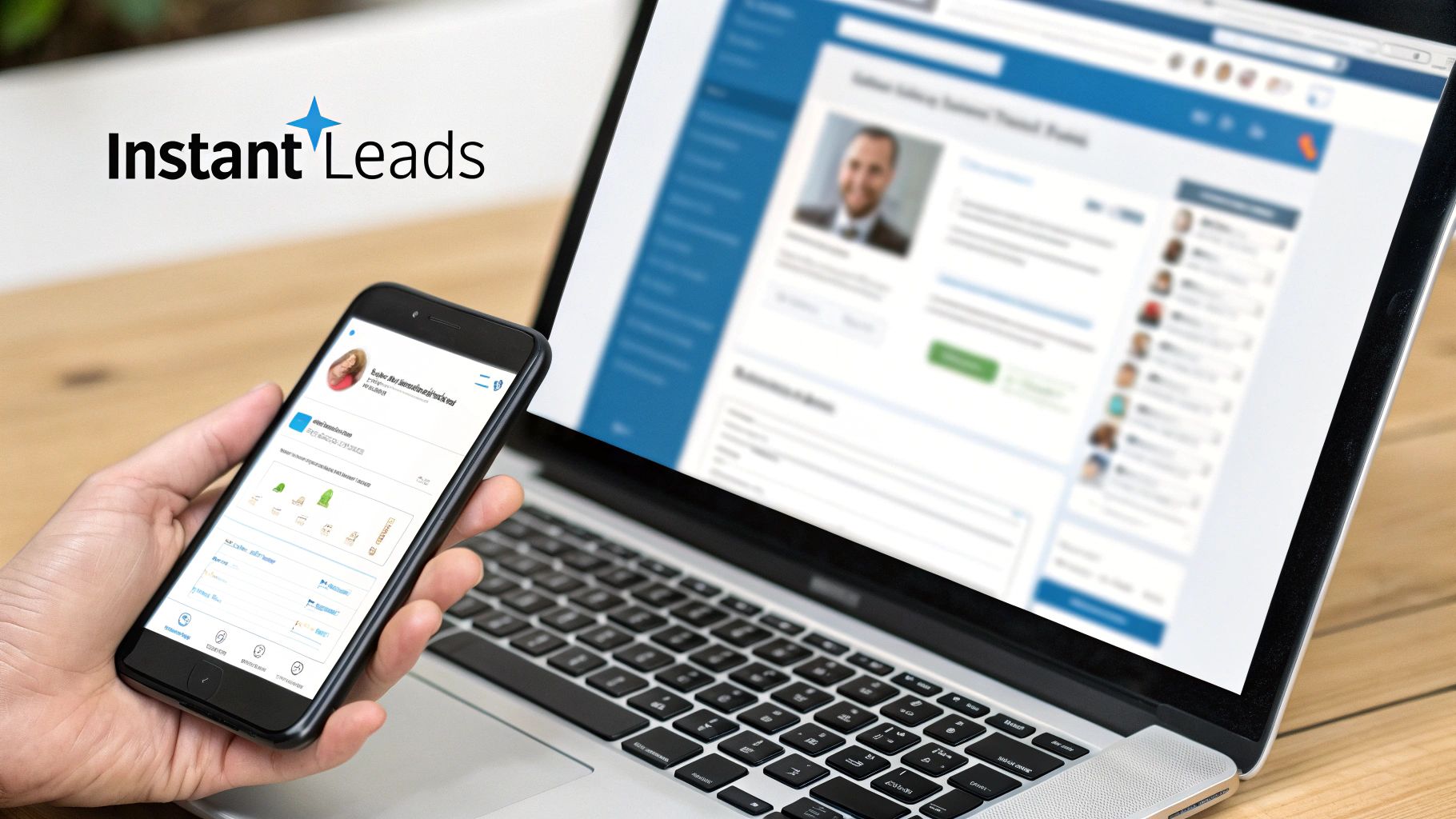
Let's bring this down to earth with a problem pretty much every business running ads has faced. Facebook is an absolute goldmine for generating leads, but getting those leads out of Facebook and into your sales process can be a painfully slow, manual job.
It’s a classic bottleneck. A potential customer fills out your Facebook Lead Ad, and their details just… sit there. Waiting in a CSV file. For you. You have to remember to log in, find the right page, download the file, and then painstakingly copy and paste everything into your CRM.
This old-school method is a conversion killer. The time gap between someone showing interest and you actually reaching out can stretch into hours, if not days. By then, their initial excitement is gone. Studies have shown that contacting a lead within the first five minutes can boost your conversion rate by an incredible nine times. Anything longer, and your odds plummet.
The Headaches of Manual Facebook Lead Management
The problem with doing things by hand isn't just about speed—it's about a clunky system that actively undermines your sales efforts.
You’re creating friction where there shouldn't be any.
Some of the biggest issues include:
- Costly Delays: As we just covered, every minute you wait, a hot lead goes cold. Your competitor who responds instantly is almost guaranteed to get the business.
- Human Error: Manually typing data from a spreadsheet into a CRM is a recipe for typos. One wrong digit in a phone number or a misspelled email, and that valuable lead is gone forever.
- No Real-Time Action: Without automation, you can't fire off an instant welcome email or a confirmation text. The lead is left in the dark, wondering if their submission even worked.
- Wasted Team Resources: Your sales team should be focused on selling and building relationships, not getting bogged down with mind-numbing data entry.
This is exactly where a tool built for automatic lead generation, like LeadSavvy Pro, comes in. It acts as the missing bridge, closing the gap between Facebook and your sales tools so you never have to lift a finger.
How LeadSavvy Pro Creates a Seamless Workflow
LeadSavvy Pro was designed to fix this one specific, frustrating problem. It turns that clunky, multi-step headache into a single, automated action that happens in the blink of an eye.
It connects your Facebook Lead Ads directly to wherever your team works.
The automated process is simple but incredibly powerful:
- A prospect sees your ad on Facebook and submits their info through your Lead Ad form.
- LeadSavvy Pro grabs that data the second it's submitted. No more CSV files.
- The lead is instantly sent to your connected tools—whether that’s a Google Sheet, your company CRM, or your email marketing platform.
- Automated follow-ups are triggered. The moment the lead arrives, you can kick off a welcome email, send an instant SMS, or create a task for a sales rep to call them.
This entire chain reaction happens in real-time, 24/7. It flips your lead generation from a slow, manual chore into a high-speed, proactive system that feeds your sales pipeline.
By automating this crucial first touchpoint, you guarantee every single lead gets an immediate, professional response. This doesn’t just massively increase your chances of making a sale; it creates a far better first impression and starts the customer relationship off on the right foot. It's a perfect example of how one smart automation can deliver a huge and immediate return.
How to Measure and Optimize Your Lead Engine
An automatic lead generation system isn’t something you can just switch on and walk away from. Think of it more like a high-performance engine; it needs regular check-ups, a close look at the data, and constant fine-tuning to keep it running at its best. If you're not measuring its performance, you're basically driving blind and just hoping you end up at the right destination.
When you optimize this engine, you start generating more qualified leads without spending more money or effort. This isn't just about collecting contacts—it's about actively improving your return on investment and building a sales pipeline that actually works.
Identifying Your Key Performance Indicators
To tune your engine, you first need to look at the dashboard. For lead generation, that dashboard is your Key Performance Indicators (KPIs). These numbers tell you the real story of your system's health, showing you what’s working and, more importantly, where the problems are hiding.
Don't get lost in a sea of data. Just focus on the few metrics that truly move the needle. For any solid lead generation system, these are the non-negotiables:
- Cost Per Lead (CPL): This is the bottom line. It tells you exactly how much cash you're spending to get a single new lead into your funnel.
- Lead-to-Customer Conversion Rate: This one is all about lead quality. It answers the most important question: "How many of these leads are actually becoming paying customers?"
- Funnel Drop-Off Rate: By seeing where people are bailing, you can pinpoint the weakest link in your chain. Are they leaving your landing page in droves? Or maybe unsubscribing after your second email?
Tracking the right KPIs turns optimization from a guessing game into a science. The data doesn't just show you what happened; it gives you a clear roadmap for what to fix next.
Getting a handle on these numbers is the first step. For a deeper dive, you can learn more about the most important lead generation KPIs you should be tracking.
Diagnosing and Fixing Common Problems
Once you have your data, it's time to play detective. Each KPI points to a specific part of your system, letting you diagnose issues with surgical precision. A problem in one area almost always has a clear, actionable solution you can start testing right away.
Let’s say you have tons of traffic hitting a landing page but almost no one is signing up. That points straight to a problem with the page itself. The issue could be a weak offer, a confusing design, or a headline that just doesn't connect. The fix? Start A/B testing. Pit different headlines, calls-to-action, or even your entire lead magnet against each other to see what works.
Or maybe your email nurture sequence has terrible open rates. The problem is almost always the subject line. Test a few new, more interesting ones to see which ones people actually click. If open rates are solid but nobody's clicking the links inside, then you know the email content itself needs a rewrite. This data-first approach lets you systematically upgrade every piece of your lead engine, making sure it’s always getting better.
Common Questions About Lead Automation
Jumping into automatic lead generation always kicks up a few practical questions. How much is this going to set me back? Is it going to replace my sales team? And where in the world do I start if I'm on a shoestring budget?
Let's clear the air and tackle the most common questions we hear from business owners and marketers. Getting these answers straight is the key to building a system that actually works for you.
How Much Does This Actually Cost?
The price tag for lead automation can be anything from totally free to a few hundred bucks a month. It really just boils down to the tools you pick and how big your operation is. The good news? You don't need a massive budget to get going.
Many of the best platforms out there have free or super affordable starter plans.
- Free Tiers: A lot of tools use a freemium model. This lets you automate a set number of leads every month without paying a dime. It's the perfect way to test the waters.
- Affordable Starters: Paid plans often kick off around $20-$50 per month, which is more than enough firepower for a small business to build a solid system.
The best way to look at it is as an investment. Think about the hours you'll save on manual data entry and the value of contacting leads while they're still hot. That return on investment almost always blows the monthly subscription cost out of the water.
Will Automation Make My Sales Team Obsolete?
This is a big one, but the answer is a hard no. Automation doesn't replace your sales team; it supercharges them. Think of it as giving your top performers a world-class assistant who handles all the boring, repetitive grunt work.
This frees them up to do what they do best—sell.
An automatic lead generation system is designed to tee up perfect opportunities for your human experts. It filters out the noise, warms up the prospects, and hands them over at the exact moment they're ready for a real conversation.
Instead of chasing down cold leads, your team can pour their energy into building relationships with highly qualified people who've already raised their hands. This leads to happier reps, way better conversion rates, and a sales process that just works better.
What Is the Best Way to Start Small?
If you're just dipping your toes in, focus on automating one specific, high-impact pain point. Don't try to boil the ocean and build a massive, complex system on day one.
A fantastic starting point for most businesses is to automate the capture and follow-up for leads from a single channel, like Facebook Lead Ads.
This approach delivers a quick, measurable win. You solve a real problem, see an immediate improvement in your workflow, and can then build out your system from that solid foundation.
Ready to automate your first lead generation channel? LeadSavvy Pro makes it incredibly simple to sync your Facebook leads directly to your CRM or a Google Sheet in real-time. Sign up for a free plan and stop downloading CSVs forever.

